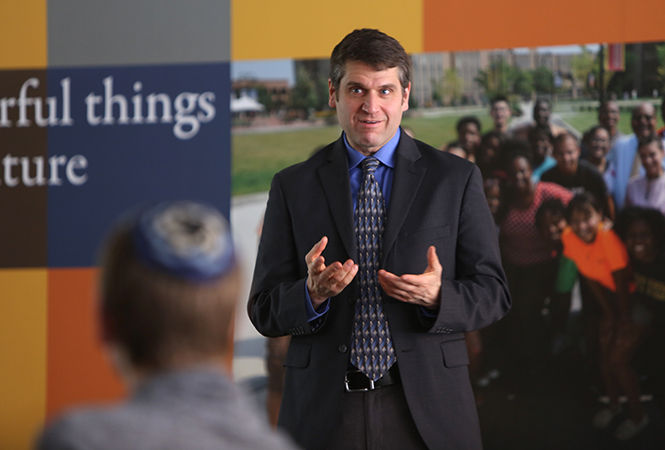Endangered Species: A language’s struggle to survive
The Kent Stater Sean Martin speaks about the importance of Yiddish to an audience in the Kent State Student center on Feb. 16, 2015.
February 16, 2015
Old Norse, Latin, Ancient Greek and Middle English are all examples of dead languages, and they are not alone.
Dead or extinct languages are exactly what they sound like. These are dialects no longer spoken or used in the real world, with the exception of special religious or traditional practices. Not only does the dialect die with the last speakers, but it’s written word, including essays, poetry, songs and other forms of useful knowledge could be lost to the world forever.
“Nobody could read [the books], so they threw them away,” said Sean Martin, associate curator for Jewish history at the Western Reserve Historical Society, describing instances in which knowledge from an extinct language could be treated.
In his presentation to faculty, students and members of the community entitled “Yiddish Lives! The Importance of Yiddish Then and Now,” Martin told attendees in the Multicultural Student Center Monday that understanding a language like Yiddish is crucial to understanding the past and learning about people’s lives.
Yiddish is an endangered language. Considered the language of the Ashkenazi Jews, it derives its roots from Hebrew and German around the 10th century.
Throughout history, Yiddish often contended with Hebrew when it came to popularity among the Jewish population. Yiddish was viewed as colloquial and casual while Hebrew was used in a higher status.
“We need to learn this language because this is a language actually spoke,” Martin said.
At the Western Reserve Historical Society, Sean Martin collects materials related to the Jewish community of northeastern Ohio and processes them as an archivist. His interest for the Yiddish language and culture began from studying Polish history.
Numerous important minds used the Yiddish language as a channel for their work, creating a large database of knowledge that could potentially become forever untapped if the language dies out, he said.
According to the 2007 U.S. Census, the number of American citizens speaking Yiddish at home had decreased from almost 180,000 in 2000 to less than 160,000.
After World War II, the language took a hard hit, since the Holocaust wiped out many native Yiddish speakers, Martin said. And in other countries like Israel after the war, Hebrew became the popular language.
However, hope is not lost for the language, as programs like the National Yiddish Book Center, Yiddish Farm, Yiddishkayt and more serve as catalysts for its revival. Even more, millennials are picking up interest in the study of the language.
“It hasn’t been done before,” Martin said in regards to the newfound interest in younger generations. “There will still be a decline in its use, but it will level off and eventually rise.”
Yiddish can even provide a key to understanding events that people may already think they understand. Knowing the language can help people understand perspectives from the Holocaust according to Martin, as it was a language spoken among many Jews in Europe.
“There are all kinds of different ways to learn online,” Martin said. “There is still hope.”
Wolfgang Davidson, a junior integrative studies major, said he found the talk interesting, as his family came from Germany in the 1990s.
“Yiddish is what I have to hold onto that it’s just important for our collective identity,” Davidson said.
The Yiddish culture also had a big part of social and political history in the U.S., Davidson said. There was an admirable socialist aspect of the Yiddish.
Yiddish is not the only language facing endangerment. Countless other dialects are facing the same fate, or have already vanished into the past. Language is seen as a portal to greater understanding, and in the case of the Yiddish language, the portal is still open to discovering unheard stories, songs and aspects of culture that define the human experience.
Contact Skye McEowen at [email protected].












